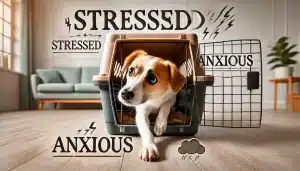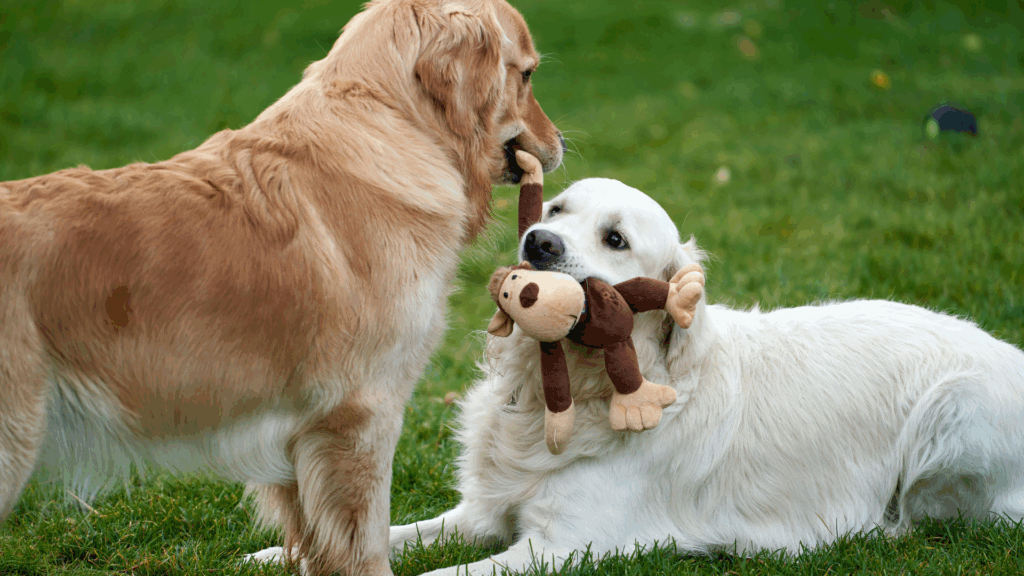Stress comes in many forms. For humans, it might look like biting your nails during a work meeting, furiously swiping through social media, or stress-eating an entire pizza when all you wanted was “just a slice.” For dogs? Well, stress might come in the form of a strategic military operation to break out of their crate like it’s Alcatraz.
If you’ve ever come home to find your dog chilling on the couch, crate door ajar (or entirely dismantled), and that unmistakable “What? Me?” expression on their face, then this article is for you.
What your dog’s crate breakout is really trying to tell you goes beyond just the need to stretch their legs. It’s time to dig deeper into what’s really going on in their furry little brains.

My Personal Crate Breakout Saga:
Let me tell you about Max. Max was a Husky mix—big, fluffy, and way too smart for his own good. His crate? It was a beautifully designed, heavy-duty, “indestructible” structure. It cost more than my first car, but I figured it was a worthy investment for a dog that needed a place to relax and recharge. Plus, I was told by a dozen dog blogs that crate training would save me from dog-related chaos. Spoiler alert: it did not.
The first time Max broke out of his crate, I wasn’t too worried. I figured I hadn’t latched it properly. After all, who could blame a guy for wanting to enjoy the house while I was gone? But then it happened again, and again…and then again. One day, I came home to find the crate door hanging by a thread, Max’s blanket shredded across the living room like confetti after a wild party. Max? He was sitting there, unbothered, like he was about to start watching Netflix.
It was the day I realized this wasn’t just a “crate problem.” It was a Max problem—and maybe, just maybe, it was a me problem too.

The Psychology Behind a Crate Breakout:
Let’s get one thing straight: when your dog goes full Houdini on their crate, it’s not just about escaping. It’s about stress. And no, I’m not talking about the kind of stress that comes from barking at the mailman or realizing they dropped their favorite toy under the couch. This is existential dog stress. Yes, that’s a thing.
Crate breakout behavior is often rooted in anxiety. Dogs can feel trapped, both physically and mentally, in crates—especially if they associate it with isolation or punishment. Dogs are social animals, and if they feel like they’re being “banished” from their human pack, they might start plotting their grand escape. It’s their way of saying, “I can’t handle this alone!”
And here’s where things get ironic: the crate, the very thing that’s supposed to be a calm and safe haven, might be the source of their greatest stress. It’s like us humans trying to “relax” by turning on the news—instant stress, right?

Your Dog’s Silent (and Not-So-Silent) Cries for Help:
You see, dogs are trying to communicate with us all the time. Sure, they can’t talk, but they make it pretty clear when something’s wrong—if you know how to listen. The crate breakout? It’s the dog version of a passive-aggressive email sent at 2 AM. Let’s break down the messages they’re really sending.
- “I’m Lonely, Dude.” The number one cause of crate breakouts is separation anxiety. If your dog isn’t used to being away from you, they’re going to freak out in that crate. Just like you freak out when your phone dies and you’re left alone with your thoughts. A breakout might be their way of saying, “Hey, I can’t do this. Where did you go?”
- “This Space Feels Like a Jail Cell.” Some dogs are claustrophobic. It’s not about whether the crate is too small (though that could be a factor). It’s about feeling confined, like they’ve been sentenced to solitary confinement without trial. They’re pleading, “I need more space to breathe, man!”
- “I’m Bored Out of My Mind.” Dogs are like toddlers. They need stimulation. When they’re left in a crate with nothing to do, they’ll entertain themselves—and by that, I mean they’ll start chewing, digging, and plotting how to escape. This is their version of texting you at work asking, “When are you coming home? I’m bored!”
- “I’m a Free Spirit, Okay?” Some dogs just aren’t crate dogs. No matter how much you try, they’ll never see the crate as their happy place. Instead, they’ll see it as an obstacle in their quest for freedom, and they’ll spend their time figuring out how to get out—think Shawshank Redemption but furrier.

Managing Your Dog’s Stress (and Your Own):
Here’s the good news: you’re not alone in this. There are ways to manage your dog’s stress (and, in turn, your own) when it comes to crate breakouts. Here’s a crash course in how to address the situation without resorting to buying more heavy-duty crates.
- Take a Deep Breath—For Both of You. First things first: relax. Stress is contagious, and if you’re frazzled, your dog will pick up on it. If they’re breaking out of their crate, don’t panic. Don’t assume they’re being disobedient or trying to “get back at you.” They’re just trying to tell you something’s wrong.
- Reevaluate the Crate Situation. Not all crates are created equal. Maybe your dog needs a bigger crate or a softer bed. Maybe they need a crate that feels more open, like a den, rather than a plastic fortress. Sometimes a little rearranging can go a long way.
- Ease the Separation Anxiety. If separation anxiety is the culprit, work on easing your dog into alone time. Start by leaving them in the crate for short periods, then gradually increase the time. Pair crate time with positive reinforcement—treats, toys, or calming music. It’s like giving them Netflix while you’re gone.
- Enrichment is Key. If boredom is the issue, give your dog something to do. Puzzle toys, chew toys, and Kong toys filled with treats can keep them occupied. It’s the dog version of giving a kid an iPad on a long car ride.
- Consider Professional Help. If your dog’s stress seems extreme, it might be time to call in reinforcements. A professional dog trainer or behaviorist can help you figure out the root cause of your dog’s anxiety and come up with a game plan to address it.

The Ironic Truth:
At the end of the day, the ironic truth is that dogs, much like humans, are trying to tell us something when they’re stressed. We, as their humans, just need to figure out what that message is.
Max? Well, after some trial and error (and a few more crate breakouts), I realized that his anxiety wasn’t just about the crate. It was about me. He had no idea how to self-soothe, relax and control his emotions when he couldn’t see, smell or hear me.
I won’t lie—it was a humbling moment to realize that I had been so focused on “training” Max to be crate-friendly that I missed the point entirely. Sometimes, the crate breakout isn’t about the crate at all. Sometimes, it’s about what’s happening inside the dog’s mind.

Conclusion:
So, next time you come home to a crate escape, don’t just shake your head in disbelief. Instead, ask yourself: what is my dog really trying to tell me? Because behind that jailbreak is a deeper story—one about connection, trust, and, yes, even stress management. After all, we’re all just trying to manage our stress, one breakout at a time.





